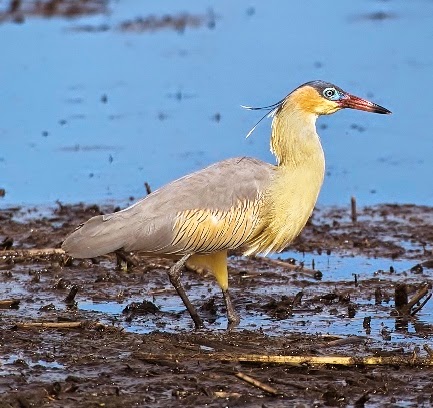 |
| Photo by Ken Erickson (Wikipedia) |
Common name:
whistling heron (en); maria-faceira (pt); héron flûte-su-soleil (fr); garza chiflona (es); pfeifreiher (de)
Taxonomy:
Order Ciconiiformes
Family Ardeidae
Range:
This South American species has two subspecies with disjunct distributions. S.s. fostersmithi is found in eastern Colombia and in northern and western Venezuela, while S.s. sibilatrix is found from Bolivia and adjacent western Brazil, east to southern Minas Gerais and south through Paraguay and Uruguay into north-eastern Argentina as far as Mar del Plata.
Size:
These birds are 50-64 cm long and weigh 370-545 g.
Habitat:
The whistling heron is mostly found in wet grasslands, but also uses dry grasslands and savannas, marshes and swamps, and pastures. They occur from sea level up to an altitude of 1.200 m.
Diet:
They mainly hunt invertebrates, including grasshoppers, dragonfly larvae, stick insects, mantids, beetles, caterpillars, various flying insects, spiders and earthworms, but also take small vertebrates such as frogs, tadpoles, eels and other small fish, and aquatic snakes.
Breeding:
Whistling herons breed in April-January, varying among different parts of their range. They nest either in solitary pairs or in scattered colonies. The nest is built by both sexes, consisting of a loose, unlined platform of twigs placed on a thick horizontal branch of a mature tree, 3-11 m above the ground. The female lays 1-4 pale blue eggs with dark speckles, which are incubated for about 28 days. The chicks are fed by both parents and fledge 1 month after hatching, but usually only 2 chicks survive until fledging.
Conservation:
IUCN status – LC (Least Concern)
This species has a very large breeding range and is described as locally common but patchily distributed. The population is suspected to be stable in the absence of evidence for any declines or substantial threats and S.s. sibilatrix it appears to be expanding its range northwards across the Brazilian cerrado.







